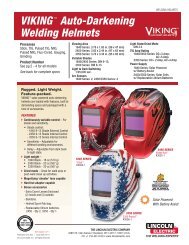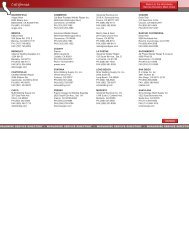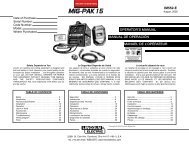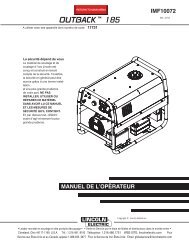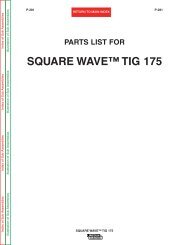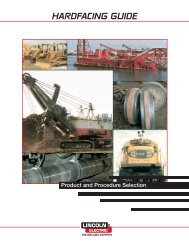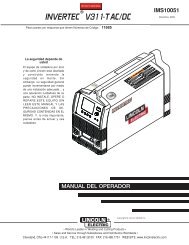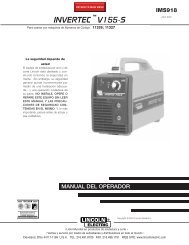Consumeables Catalog - Lincoln Electric
Consumeables Catalog - Lincoln Electric
Consumeables Catalog - Lincoln Electric
You also want an ePaper? Increase the reach of your titles
YUMPU automatically turns print PDFs into web optimized ePapers that Google loves.
PACKAGING<br />
Storage & Handling<br />
Stick Electrodes<br />
Storing Low Hydrogen Electrodes<br />
Low hydrogen electrodes must be dry to perform<br />
properly. Unopened hermetically sealed containers<br />
provide excellent protection in good storage<br />
conditions. Opened cans or electrodes should be<br />
stored in a cabinet at 120°-150°C (250°-300°F).<br />
Moisture resistant electrodes with an “R” suffix<br />
have a high resistance to coating moisture pick-up.<br />
However, all low hydrogen electrodes should be<br />
stored properly, even those with an “R” suffix.<br />
Standard EXX18 electrodes should be supplied to<br />
welders twice per shift. Moisture resistant types<br />
may be exposed for up to 9 hours. Specific code<br />
requirements may indicate exposure limits<br />
different from these guidelines.<br />
Depending on the amount of moisture absorbed<br />
and other factors, moisture pickup can degrade<br />
weld quality in various ways:<br />
1. Moisture in low hydrogen electrodes may<br />
cause porosity. This porosity could be<br />
completely subsurface and require x-ray<br />
inspection or destructive testing. The porosity<br />
could also be visible, external porosity.<br />
2. High moisture can also lead to excessive slag<br />
fluidity, a rough weld surface, and difficult slag<br />
removal.<br />
3. Excessive moisture in low hydrogen electrodes<br />
will lead to elevated levels of diffusible hydrogen<br />
which, in turn, can lead to hydrogen-induced<br />
weld cracking and/or underbead cracking.<br />
Re-drying Low Hydrogen Electrodes<br />
Re-drying, when done correctly, restores the<br />
electrodes’ ability to deposit quality welds. Proper<br />
re-drying temperature depends upon the electrode<br />
type and its condition. One hour at the listed final<br />
temperature is satisfactory. DO NOT dry electrodes<br />
at higher temperatures. Several hours at lower<br />
temperatures is not equivalent to using the<br />
specified requirements.<br />
Electrodes of the E8018 and higher strength<br />
classifications should be given no more than three<br />
1-hour re-dries in the 370°-430°C (700°-800°F)<br />
366 ı THE LINCOLN ELECTRIC COMPANY<br />
range. This minimizes the possibility of oxidation of<br />
alloys in the coating which would result in lower than<br />
normal tensile or impact properties.<br />
Any low hydrogen electrode should be discarded if<br />
excessive re-drying causes the coating to become<br />
fragile and flake or break off while welding, or if there<br />
is a noticeable difference in handling or arc<br />
characteristics, such as insufficient arc force.<br />
Electrodes to be re-dried should be removed from the<br />
can and spread out in the oven because each electrode<br />
must reach the drying temperature.<br />
Storing Cellulosic Electrodes<br />
Electrodes in unopened <strong>Lincoln</strong> cans or cartons retain<br />
the proper moisture content indefinitely when stored in<br />
good condition.<br />
If exposed to humid air for long periods of time,<br />
electrodes from opened containers may pick up enough<br />
moisture to affect operating characteristics or weld<br />
quality. If moisture appears to be a problem, store<br />
electrodes from the opened containers in heated cabinets<br />
at 40° to 50°C (100° to 120°F).<br />
Storing and Re-drying Non-Low Hydrogen Electrodes<br />
Electrodes in unopened <strong>Lincoln</strong> cans or cartons retain<br />
the proper moisture content indefinitely when stored in<br />
good condition.<br />
If exposed to humid air for long periods of time,<br />
electrodes from opened containers may pick up enough<br />
moisture to affect operating characteristics or weld<br />
quality. If moisture appears to be a problem, store<br />
electrodes from the opened containers in heated<br />
cabinets at 40° to 50°C (100° to 120°F). DO NOT use<br />
higher temperatures.<br />
Some electrodes from wet containers or long exposure<br />
to high humidity can be re-dried. Follow the procedures<br />
below for each type.<br />
Using longer drying times or higher temperatures<br />
can easily damage the electrodes.<br />
For drying, remove the electrodes from the container<br />
and spread them out in the furnace because each<br />
electrode must reach the drying temperature.



